SOMETIMES CALLED SPARROW GRASS, SOMETIMES ASPARAGOS
Many Reasons to Grow Asparagus
In my book Weedless Gardening, I begin the section about asparagus with the statement “Forget about the usual directives to excavate deep trenches when planting one- or two-year-old crowns of asparagus.” More about planting in a bit; let me first lay out my case about why YOU should grow asparagus.
With most vegetables, by the time you taste them fresh-picked somewhere, it’s too late in the season to plant them in your garden. Not so with asparagus. 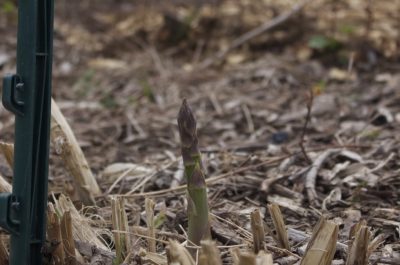 Borrow a taste from a neighbor’s asparagus bed, or from a wild clump along a fencerow, and you’re likely to want some growing outside your own back door. Minutes-old asparagus has a very different flavor and texture (both much better) than any asparagus that reaches the markets. The time to plant is now.
Borrow a taste from a neighbor’s asparagus bed, or from a wild clump along a fencerow, and you’re likely to want some growing outside your own back door. Minutes-old asparagus has a very different flavor and texture (both much better) than any asparagus that reaches the markets. The time to plant is now.
A big plus for asparagus is that it’s a perennial plant, so once a bed is planted, more time is spent picking than any other activity. An established planting can reward the gardener with tender green spears for a half a century or more. My asparagus bed is thirty-six years old and about twenty-five feet long; on every warm day, the bed offers enough stalks for a meal for two.
Deer and rabbits don’t have a taste for asparagus so no need to plant it within the vegetable garden or any protected area. (My dogs have eclectic palates, and they joined in on the harvest until I made clear that asparagus was not dog food.)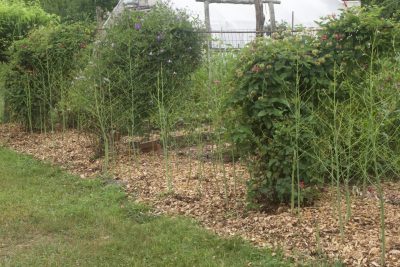 Planting asparagus beyond the confines of the vegetable garden works out well because the lacy, green foliage stands as a backdrop for perennial flowers. Or, it can soften the line of a wall or fence.
Planting asparagus beyond the confines of the vegetable garden works out well because the lacy, green foliage stands as a backdrop for perennial flowers. Or, it can soften the line of a wall or fence.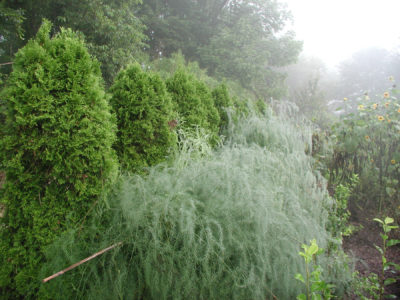
Traditional Planting Method is Unduly Hard
Now, back to what I wrote about planting asparagus in Weedless Gardening, (available, by the way, at the usual sources as well as, signed, from my website, here).
The traditional method for planting an asparagus bed entails digging a trench a foot or more deep, setting the roots — one-year-old roots establish best — in the bottom with a covering of a shovelful of soil, then filling in the trench gradually as the stalks grew.
Whew! I planted my own asparagus bed just deep enough to cover the upward pointing buds from which the roots radiate, and the plants do just fine.
The main reasons for the traditional deep planting were to protect the crowns from overzealous hoes or other tillage implements, and from knives during harvest. But I don’t till my asparagus bed. I just pile on some mulch every year. And I harvest by snapping the stalks off with my fingers, rather than cutting into the soil with a knife.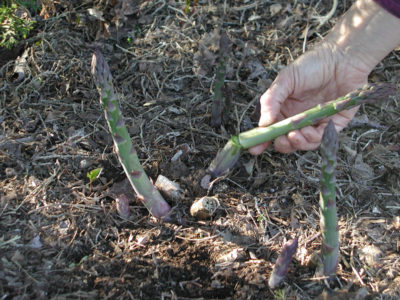
Gardeners with patience sow seeds, which need a year more in the ground than roots before harvest can begin. Seed sowing is straightforward, except that germination is slow. Soak the seeds in water for a few hours before sowing to shorten germination time.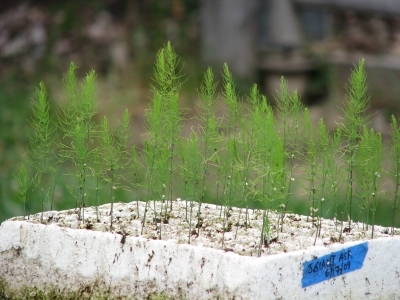
Whether starting with seeds or plants, the bed needs to be planted in full sun, with eighteen inches between plants in the row, and four feet between rows.
Tune into Asparagus’s Life Cycle
Although asparagus roots live on year after year, the feathery tops turn brown and die back to the ground every fall. 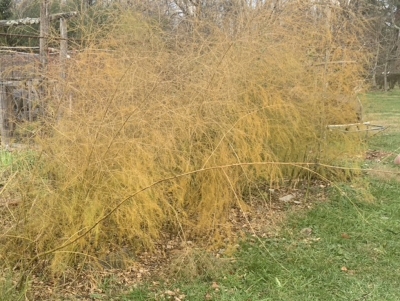 Then, when the spring sun warms the soil, energy stored in the roots fuels growth of the spears. As the spears grow higher and higher, feathery green branches unfold. Photosynthesis within these green branches pumps energy to the root system, energy that keeps the roots alive through the winter and fuels early growth of spears the following spring, thus completing the plant’s annual cycle. (The true leaves of asparagus, which are the small scales on the stems, are much reduced in size and function; the green stems take on most of the job of photosynthesis for this plant.)
Then, when the spring sun warms the soil, energy stored in the roots fuels growth of the spears. As the spears grow higher and higher, feathery green branches unfold. Photosynthesis within these green branches pumps energy to the root system, energy that keeps the roots alive through the winter and fuels early growth of spears the following spring, thus completing the plant’s annual cycle. (The true leaves of asparagus, which are the small scales on the stems, are much reduced in size and function; the green stems take on most of the job of photosynthesis for this plant.)
Harvesting asparagus steals some of the energy that had been stored in the roots. The plant must build adequate reserves before tender stalks can be spared for our plates, and then each season left enough time to grow freely to replenish its energy reserves.
The first season of planting, no asparagus is harvested; if good growth was made the first season, some can be harvested the second season. The plants are ready for a full harvest by the third season.
Full harvest means cutting all stalks from the time they first emerge until about the end of June.  Remember, the plants do need some time to nourish their roots in preparation for winter. Following the last harvest, all new green stems are left untouched until their summer job is over, as they turn brown in the fall.
Remember, the plants do need some time to nourish their roots in preparation for winter. Following the last harvest, all new green stems are left untouched until their summer job is over, as they turn brown in the fall.
Asparagus grew wild along the shores of the Mediterranean before plants were transplanted to Greek and Roman gardens. The steaming dish of asparagus on my table today is virtually identical to the asparagus enjoyed by the ancients over 2000 years ago. Even our word for the vegetable is nearly identical to, and derived from, the Greek word asparagos.
Asparagus came to America with the early colonists and has been cultivated extensively here since then. The red berries borne on female plants attract birds that spread the seed, so asparagus now pops up as an “escape” from cultivation along fencerows and roadsides.

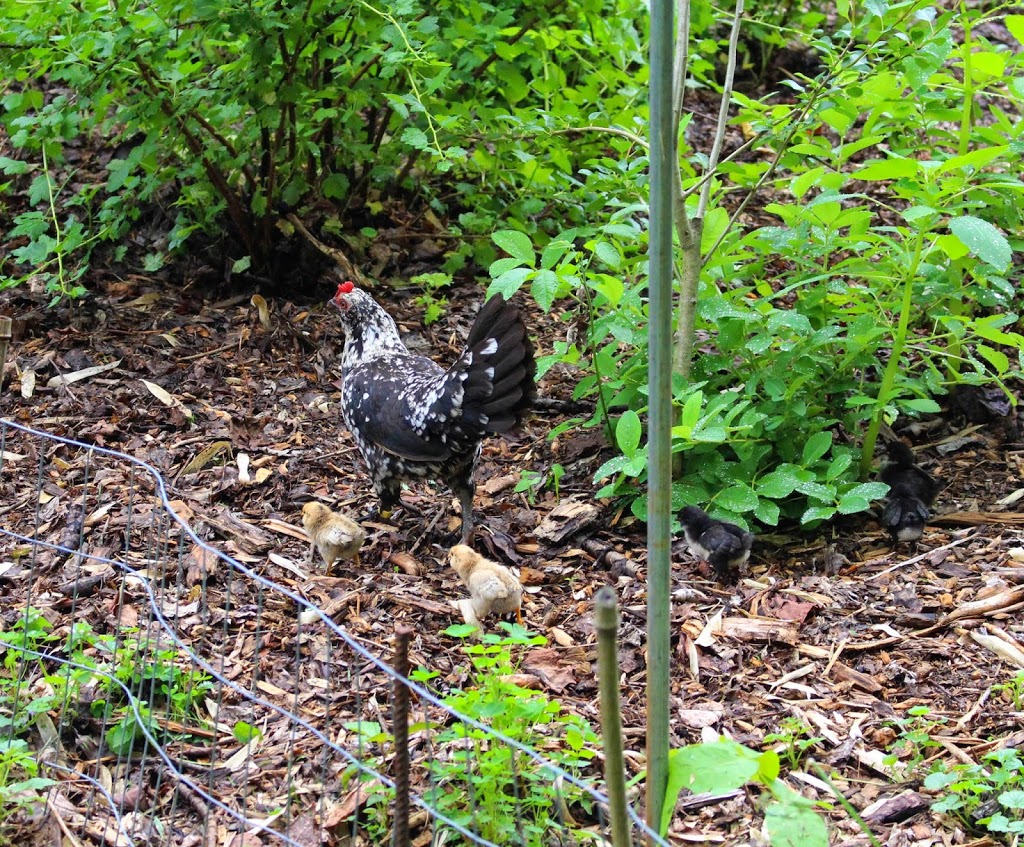

I let some my plants uncut. Then, misummer or beyond, I cut the fronds back and get new sprouts. I only do this once a year per section of plants so they’ll have plenty of time to store up energy.
Yes, that would extend the season of eating fresh asparagus. I’m content to eat them just in May and June.
Hi Lee, and thank you for sharing your gardening experiences– often very helpful information! My 16 foot bed has spread, apparently by seeds, to an adjacent bed and is already shooting up many thin stalks. Does it need help with over crowding or will it take care of that itself?
Delighted to hear that it can be grown outside the fence!
Yes, they’ll probably be overcrowded which will result in spindly, weaker stalks. Thin them to about a foot apart.
I agree.
I don’t cook my asparagus. I accidentally discovered how delicious it is raw when a small piece broke off and I popped it in my mouth. It tasted like raw fresh green peas. So now, if I have enough to take into the kitchen, it goes in a salad. More often, it just gets eaten in the garden.
Can you tell me about the differences between the male and female asparagus plants? I understand that one is more productive than the other. My asparagus bed is now 2 years old and I want it to flourish.
And, as a side note, I bought some Malabar spinach and know nothing about it, I am in zone 4b. Can I grow it in a 15 gallon pot?
Thanks!
Robin
You can tell by looking at the flowers, which will have either male or female parts. Even easier to see, later in the season, are the plants with the red berries; these plants are the females.
As far as the Malabar spinach, yes, you can grow it in a 15 gallong pot — or even one a lot smaller.
I love my asparagus bed but the beetles have become so bad that my plants are declining.I try to handpick them into soapy water but I just can’t keep up. What do you recommend for this problem
For the two months during which you harvest asparagus, pick everything each time. That removes the food source for the beetles, starving them out. When you let the plants grow from July on, few beetles will be around.
Lee, might you have any leads to a person who can assist develop a small garden? I just turned 80 years old and love working outside I am currently assisting my son build a wall out of gigantic rocks. My son and his fork lift tractor do all the work I just pick and choose the stones that might fit best. Anyway I would love gardening.
John novi
Hi John, I suggest http://earthdesignscooperative.com in Rosendalae.
Our bed is 18 years old now and is no longer in rows, which does make it a little harder to tiptoe in the bed. I also did not sign them so deep and they have been fine. I planted Purple Passion which to our taste is far superior to the green varieties. It is also stringless.
Asparagus is definitely the gift that keeps on giving (with help from a lot of composted manure).
I’ll have to try Purple Passion. Also, I didn’t now asparagus has “strings.” (Ha, ha, but I know what you mean. Fresh pick, my asparagus don’t have strings either.)
I harvested our first vegetable of the season this morning, here in central MA. I took you advice a couple of years ago and didn’t plant asparagus very deep. They did better than the deeper planted asparagus. I also found a lot of seedlings that self-started in an older, crowded bed. I harvested, nurtured and planted those seedlings. They are doing nicely, some as thick as a pencil, some as thin as a drinking straw.
Questions:
-When should I stop harvesting (I don’t want to spoil next year’s harvest)?
When should I start harvesting the thin shoots from the young plants?
Thanks for all your posts and gardening tips. L. P.
On an established be din this part of the country, I harvest until the end of June. I pick everything, even thin ones. Picking everything each time doesn’t leave any food for the early asparagus beetles. I’ve never had a problem with them by harvesting this way (and then letting plants grow after June)>
Excellent article Lee thank you! I have always wondered why it was reccomended to plant so deep – my ‘Mary Washington’ reseeds with abandon and I let the male plants go a season before plunking them into a spot in my asparagus bed. I just picked my asparagus for the 2nd time last evening. I plant all the teeny runts left over in our bins at the nursery I own in z5 Central Oregon. Can I have presmission to share this on our Facebook page? thanks!
Yes, do share, with a link to my blog please.
Good to know rabbits and deer don’t care for them. So it musta been the groundhog that tipped our earliest shoots. The bed is under hooped mesh now. (Groundhog resides in neighbor’s yard and is out of our pest-control reach.)
News flash: After I posted this, some people commented that rabbits or deer did eat their asparagus.